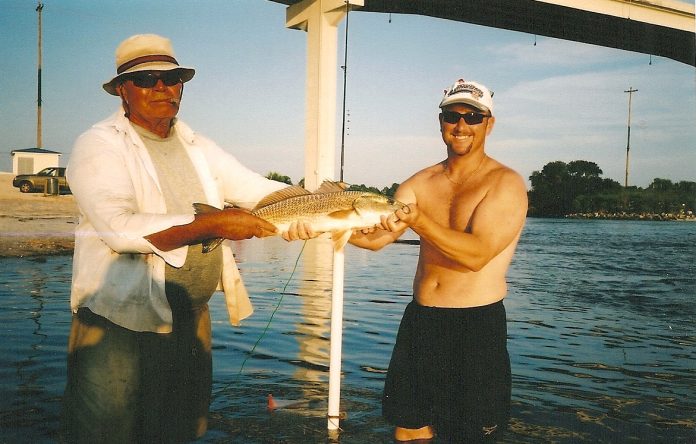If I had to choose one fish to catch the rest of my life, it would be a redfish. Redfish are a challenge on lures and they fight with excellent strength. They do not give up easily. Our habitat: Redfish are distributed all around Tampa Bay. The total reach of redfish: Around to Texas and north along the Atlantic to North Carolina. Tampa Bay redfish are broadcast spawners. East coast of Florida giant redfish are inshore year-round. On the Gulf coast we only have big oversize redfish in late August or sometime in September and usually only in the passes.
Times have changed. I had 20 years of consistent redfishing in Tampa Bay. The past four years redfish have lingered outside their normal behavior. Two particular locations: Used to target redfish all the time. Now, rare to find one there. My theory: More people. Redfish are extremely sensitive to human noise. I believe that the numbers of redfish are about the same, but the location of redfish has changed. My suggestion: Get as far away from other people as you can. The more remote you are, the more likely you are to find happy redfish. My guess: Redfish will be better to the north in years to come. Fewer people means better redfish opportunities.
Personally, I haven’t killed one in over four years. A guide, the decision was: The more redfish are let go, the better it is for business. I don’t fault anyone for keeping them. I pride myself that others have followed the example I have set. I’m sure it has helped. Those beautiful, golden bronze bodies, I like to see lots of redfish. I’ll eat the other fish if I want it for dinner. My redfish will go free.
Regulations nearly unchanged for decades the slot is 18 to 27 inches. An experiment allowed two redfish in Northwest Florida. A mistake, that rule was changed back and statewide it is one redfish per person.
Under the regulations you can harvest one fish per day. Compare to speckled trout. Four fish allowed. I could keep a limit of trout every day and not affect their numbers. If I kept a redfish every day, in three months’ time I would have wiped out one pod all by myself. Numbers. Simple numbers. I likely will rarely keep a redfish again in my life.
Myself and all the other leading guides around Florida on the 18 to 27 inch slot: And 18 to 21 inch fish is a waste. The slot should be changed. We are fine with leaving the upper end at 27, but why not have people releasing those fish that hardly have any meat on them? A suggestion that has fallen on deaf ears.
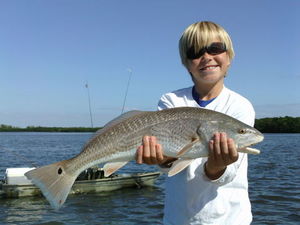
Redfish are a great opponent. Moody, you have to be assertive a lot of the time. Exact technique is important. The reason: Water depth mostly. Most redfish are caught in under a foot and a half of water. Using lures, you have to have great command. Using bait, not a big deal. You are just feeding them. But doing it my way: With lures, you have to be aggressive and you have to really “know how your lure swims.”
Right out of the gate, with your trip planning: Learn the tides. You will not have good redfish action when there is no water movement. Tides that have two feet of water movement is a situation when you should find feeding redfish. Slack tides are just not very fruitful. High or low pressure settled in: Bad for all fishing. You want a moving barometer.
You have your bait choices. To me, redfish is a “paddletail” situation. I will catch them on some other lures but 90% of the time I am throwing them the 3-inch mullet by 12 Fathom. Second choice in plastic baits: The Buzz Tail Shad. At times they aren’t turned on by the mullet. My suggestion? Try throwing the Mirrolure Mirrodine. This lure works on days they don’t want other lures. My choice in jighead: 3/16 or 1/8-ounce. Any heavier is a mistake. If you are after redfish in under a foot of water a 1/16-ounce jighead is an excellent choice.
The terrain: What’s the bottom? I would say that the locations I find redfish have one thing in common. Grass. Seagrass bottom isn’t uncommon around Tampa Bay. Redfish find things to eat in the grassy areas. I have found that areas that are a mix of eel and turtle grass are some of the best spots to find redfish. Low tide areas, with shallow water and presence of redfish are often pure turtlegrass areas. Sand patches are HUGE for redfishing. Small sand patches otherwise surrounded with grass are places that redfish lay in wait. When they are over the grass they are foraging. When they are laying on sand, they will attack things that enter their field of vision.
Gearing up for redfish: Use medium outfits. You want something you can cast a long way. The guy who makes longer casts catches more redfish. I like using the lightest stuff I can for all my fishing. Redfish, I would use 15-pound braid and a 20-pound fluorocarbon leader. Your rod: I prefer seven-foot, medium power, fast action. The reel doesn’t matter so long as it can fit on a decent amount of the braided line. Redfish will go on some drag pulling runs, but it is rare where they take all of your line.
If the tide is going to be extremely low, the school will swim off the flat. Stay close to the school to see where it goes. When the fish leave the flat, the school slows and starts to feed. When the tide is medium low, the school stays on the flat until the tide starts to come in. The school then moves back to the area where it was during the last high tide.
Redfish are in six inches of water that is thick turtlegrass. Your best option is to switch to a very light weedless jighead. Weightless isn’t a bad option. Instead of the mullet, use the Slam R or the Buzz Tail.
There are times where the Buzz Tail Shad will outperform the other lures. The Buzz Tail enters the water quieter than any other lure. It is a secret weapon for the tough days.
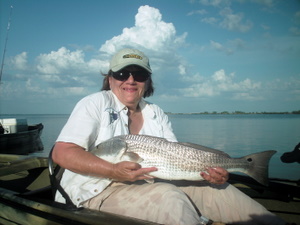
Simply catching redfish, using natural baits. There isn’t much to it. You get where the redfish are, and you feed them. They will eat almost anything you put in front of them. Shrimp are a favorite for the live bait guys. Problem is: Everything eats shrimp. To me, the #1 bait is cut pinfish. You want fresh “caught that day” pinfish. Take a scissors. Use tiny hooks to catch pinfish, cut them with the scissors and throw them out for the redfish. It stays on a hook good and the other pinfish don’t clean the meat off as fast as if you used something like a chunk of ladyfish. This is a way to catch a lot of redfish and not have to use any skill to do it. Not the way I do it, but it is an option.
Locating redfish isn’t difficult. If you stick to certain principles, your success should be maximized. Highest tides: They are up against the trees. Lowest tides: They are in the ruts on the outside of the flats. At “intermediate tides” you can intercept them in the middle of the flats. My success mid tide is better than others because I studied the flats around Tampa Bay for years. I would go out with binoculars on wintertime low tides and study the contours of a flat. That information helps me find redfish year-round.
Moving along by kayak you should be scanning the water but you should pay attention to the water right in front of you. Redfish won’t dart away until your kayak is almost on top of them. If you see multiple spooking redfish odds are there are more within casting distance.
High tide: Success is best if you make good decisions. The biggest is: Don’t set up in their highways. The highest tide the fish will be traveling right on the trees. Stay back so that your position doesn’t affect the progress of the fish along the shoreline. “Almost high tide” the fish will likely be 5 to 10 yards off the trees.
It started out low tide. Redfish climb the flat as the water rises. Exposed areas at low tide creates stunned organisms the redfish eat. They capitalize on these meals with the rising water. This beginning of a rising tide is your best chance to see “tailing redfish.” A tailing redfish is one that has his head jammed down into the mud trying to get something to eat. The water is shallow enough where the fish’ tail comes out of the water and into the air. The tailing redfish is rare. Lots of people talking about tailing redfish are talking about mullet, a common mistake.
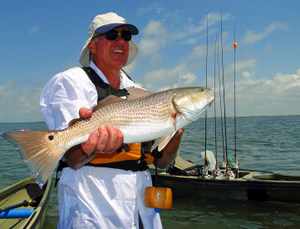
Redfish have a mouth that is rock hard. So many other species the hook gets set without any action. With redfish when you get a strike you want to drive that hook point home.
Topwater lures for redfish: Fun. And frustrating. Redfish have an offset down mouth, millions of years of evolution, eating stuff off the bottom. Redfish roll on topwater lures to get their mouth around it. When I fish topwater lures for trout, I let them do all the work. No hookset is necessary. For redfish I do something “in between.” A redfish is after my topwater lure, when it rolls on the lure I will crank the handle a turn and see if the hook sets INSTEAD of a hookset. The reason: If the fish doesn’t hook up, it doesn’t give up on the lure. If you do a hookset on a redfish and he doesn’t have a hook in its mouth the lure is going to fly out of the water and that redfish is going to be gone.
The guy who is good at catching redfish knows what he is looking at. Redfish, if in any numbers, will push a little water. Sometimes is it very subtle. Casts to areas with wakes produces better results than blindcasting to areas with no water movement. Certain times of the year a redfish wake can be very impressive. Most of the year it is subtler.
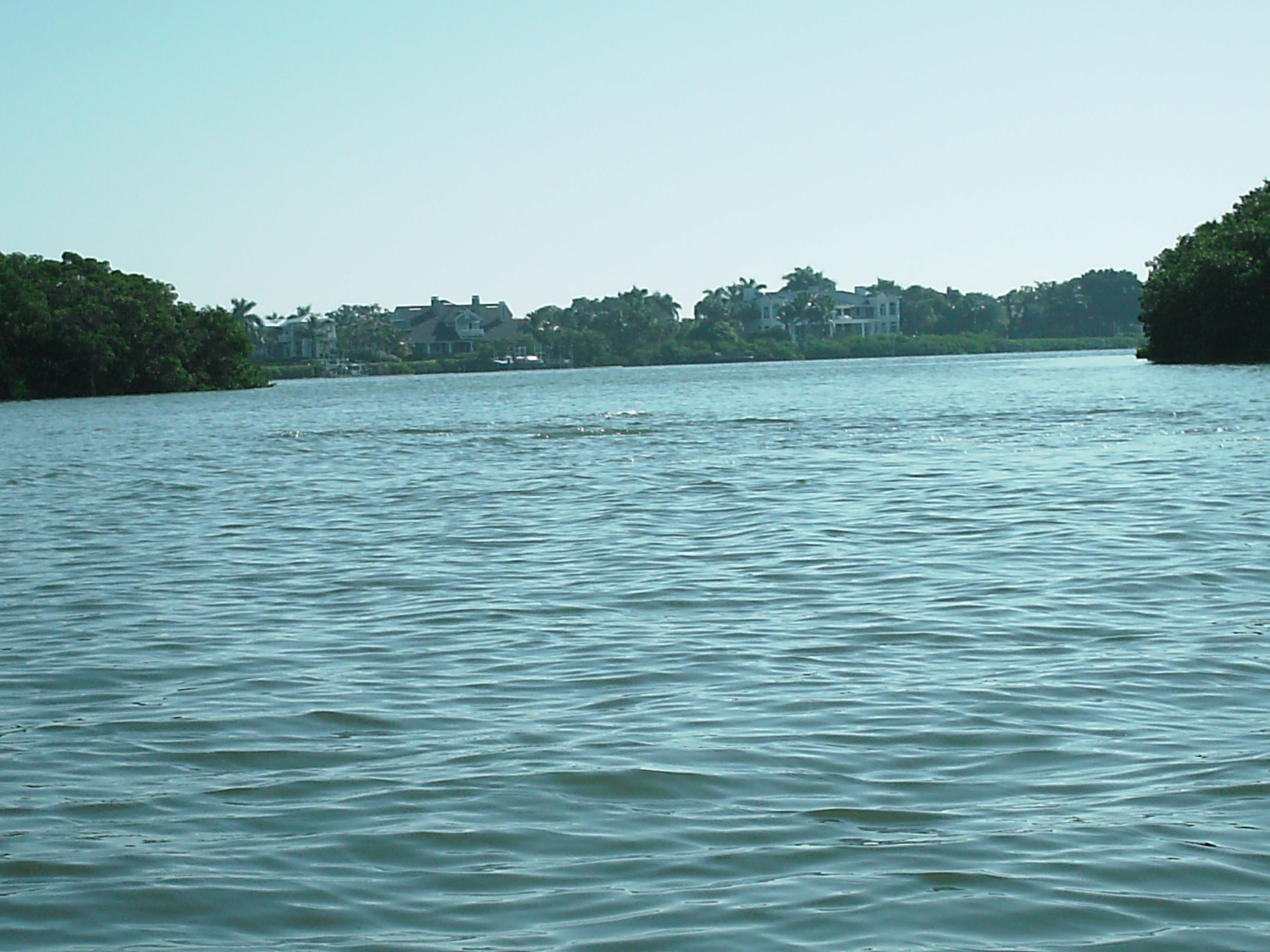
Generally, to be successful with redfish, using your standard paddletail on a jighead, already mentioned: Long casts. “Getting control of the lure” means clicking the bail over before the lure hits the water. This means you have a tight line. In shallow water, this is critical. From here it is what I call “pace.” Proper pace is the lure swimming the slowest speed possible without hitting the bottom. In a foot and a half of water this is exact technique. Too fast: You won’t get as many strikes. Keep in mind, redfish feed “head down.” If you are moving the lure the minimum speed the fish will sense the lure, turn and look at it, follow it and strike it. The proper hookset and you have your redfish.
From past articles: The kayak = The redfish advantage. Low to the water. Quiet. Approaching redfish by kayak is the easiest way for success. The guys in power boats it is more important that their casting skills are good. Their advantage, standing in a boat you can “see” more redfish.
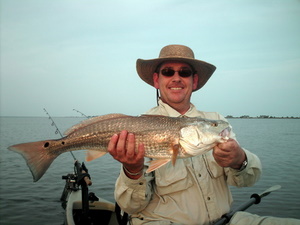
Eating redfish. If you took your fillet and throw it in the oven, you will never want to eat it again. Redfish, like sheepshead have to be done a specific way. I would limit it to one of two ways. Cast iron skillet, dry, blacken the meat. Or, olive oil hot, fillets into the hot oil, flip it a few times. They are good these two ways but extremely fishy if you try to cook it like other fish. Like I said, I would rather eat something else anyway.
The redfish is a very special target. The most challenging on lures: Success is something to be proud of. If you want to improve your fish fighting technique, spend more time fighting redfish. You have to use good technique to finish these battles. Learn to “use the rod.”
The easiest time of year to catch redfish? October, November. March, April. Truth of the matter: We have redfish to be caught year-round. Sometimes it can be great in August. Sometimes it doesn’t get good until the end of September. But you can almost always catch one any time of the year IF you have the right plan. Great redfishing can exist in the dead of winter. December and January: mid-morning. March/April redfish are what I call “head up and feeding.” The return of the sardine: Redfish are taking advantage of all the food in the water column and less likely to have their head down in the mud. That makes them easier to catch on a lure. 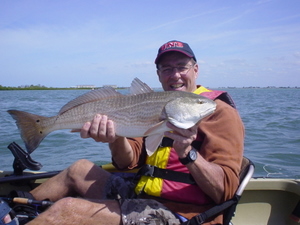
An interesting fact: Redfish don’t jump. Other people tell me they have seen it. I would dispute it. I’ve had them come out of the water to get on top of a topwater lure but I have never seen a redfish do anything that I would classify a “jump.”
Neil Taylor
Strike Three Kayak Fishing
727-692-6345
Neil runs kayak fishing charters out of the Tampa Bay area. He is an outdoor writer, speaker and radio show host. Neil is the owner of capmel.com. Kayak Fishing Skool is the fourth Thursday of every month. A free seminar with a raffle, Neil talks on current events and how to be better at catching fish around Tampa Bay.
Neil is host of the Captain Mel Classic. Redfish and trout: All amateur, all lure. The Classic is held every spring, usually in May.
- The Neil Blog… - July 26, 2023
- The Catfish - July 26, 2023
- update - July 22, 2023
